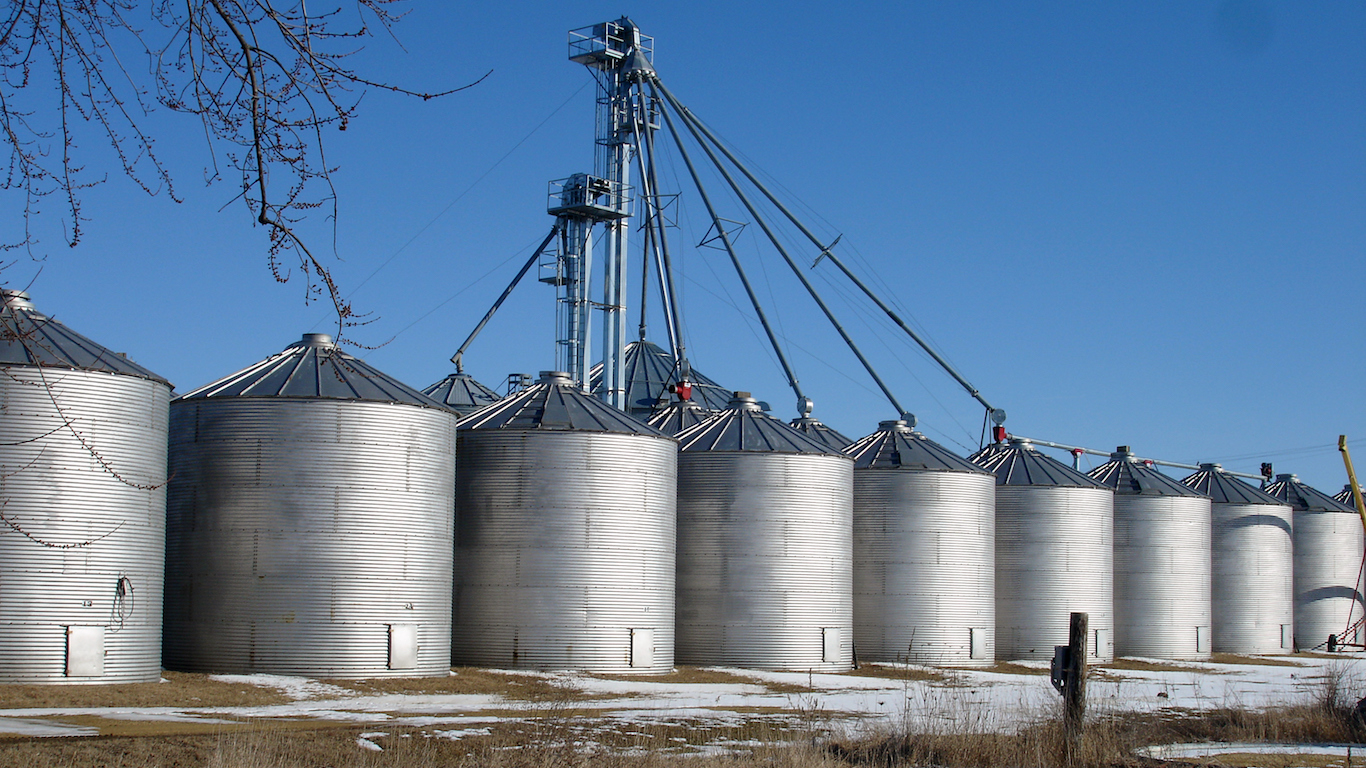Special Report
America's 25 Thriving Industries

Published:
Last Updated:

Adding $18.6 trillion to the world’s economy in 2016, the U.S. is a behemoth without equal. Massive as it is, it is not more than the sum of its parts — a handful of underlying sectors that are composed of smaller sub-sectors, which can be further broken down to a few hundred more specialized industries.
Subject to ever-changing market forces, the industrial composition of the U.S. economy is anything but static. Several factors, such as the improving job market, aging population, rapid technological advancement, and evolving consumer tastes, have led to the rise and fall of entire industries in the United States.
Over the past decade, these market forces have galvanized a number of industries — in some cases contributing to nearly triple employment growth. 24/7 Wall St. reviewed annual employment data from the Bureau of Labor Statistics from 2007 to 2016 to identify America’s 25 thriving industries. Not confined to a single segment of the economy, the industries on this list represent a range of disparate sectors including manufacturing, health care, education and agriculture.
Click here to see the America’s 25 thriving industries.
Click here to see our detailed findings and methodology.

25. Goat farming
> Employment growth 2007-2016: 53.9%
> Employment total: 474
> Wage growth 2007-2016: 8.8%
> Avg. annual wage: $27,076
Goat farming industry is one of many industries in the agriculture sector that had strong employment growth over the past decade. The number of Americans working in goat farming climbed from about 300 in 2007 to over 470 in 2016, a 53.9% employment increase.
Growth in the goat farming industry is driven largely by increasing demand for goat dairy products such as milk and cheese, which some consider healthier than cow dairy products. Goat cheese typically has higher protein content, less cholesterol, and is easier to digest than cow cheese.
[in-text-ad]

24. All other information services
> Employment growth 2007-2016: 54.3%
> Employment total: 17,916
> Wage growth 2007-2016: 57.3%
> Avg. annual wage: $81,076
While employment in information services such as libraries and news syndicates has declined over the past decade, the number of workers employed in all other information services — such as press clipping services, stock photo agencies, and telephone-based information services — has expanded substantially. Annual revenue for Shutterstock, one of the internet’s largest stock photo providers, has increased nearly tenfold in the last several years, from $52.7 million in 2008 to $494.3 million in 2016. In total, the number of establishments engaging in these information services has more than doubled in the last 10 years, and employment in the industry rose from 11,608 in 2007 to 17,916 in 2016, a 54% jump.

23. Offices of specialty therapists
> Employment growth 2007-2016: 54.6%
> Employment total: 363,454
> Wage growth 2007-2016: 15.7%
> Avg. annual wage: $43,967
The aging U.S. population affects how and where many Americans spend their money and has sweeping economic implications. The offices of specialty therapists is one of several industries benefiting from the growing number of elderly Americans, who often require more frequent medical care. Another reason for the increased demand for specialty therapists, such as speech therapists, occupational therapists, and physical therapists, is likely also the increasing number of Americans with health insurance.
The number of specialty therapists in the United States climbed by nearly 55% in the past decade, from 235,000 to 363,500.

22. Wheat farming
> Employment growth 2007-2016: 54.9%
> Employment total: 6,341
> Wage growth 2007-2016: 36.6%
> Avg. annual wage: $34,206
The rise in the number of small-scale local farming operations has contributed to increased employment in a number of agricultural industries. The number of wheat farms in the United States rose from 1,537 in 2007 to 2,122 in 2016, a 38.1% increase, and the number wheat farm workers rose by 54.9%. While global wheat prices have fallen in recent years, the rising demand for artisanal, farm-to-table bread products may have increased incomes for some industry workers. Overall, the average annual wage for wheat farmers rose from $25,040 in 2007 to $34,206 in 2016, a 36.6% increase. By comparison, the average annual wage for all U.S. workers rose 20.6% from $44,458 to $53,621 over the same period.
[in-text-ad-2]

21. Offices of all other health practitioners
> Employment growth 2007-2016: 56.1%
> Employment total: 139,921
> Wage growth 2007-2016: 13.7%
> Avg. annual wage: $43,278
The all other health practitioner classification includes all medical practitioners other than physicians, dentists, physical therapists, speech therapists, audiologists, chiropractors, podiatrists, and mental health professionals. The industry, which includes hypnotherapists, homeopathic doctors, and acupuncturists, is one of several in the health care and social assistance sector to make this list.
Total employment in offices of all other health practitioners expanded by 56.1% since 2007, more than nearly any other industry in the United States. Industries within the healthcare and social assistance sector have been growing rapidly due largely to the aging U.S. population and expansion of health insurance coverage under the Affordable Care Act.

20. Wineries
> Employment growth 2007-2016: 59.4%
> Employment total: 60,436
> Wage growth 2007-2016: 5.0%
> Avg. annual wage: $44,015
The number of wineries in the United States has nearly doubled in the last 10 years, and employment in wineries climbed by nearly 60%. Much of the the industry’s growth likely took place in California. Some 85% of wine produced in the United States comes from California, and the state ranks as the fourth largest wine producer in the world after France, Italy, and Spain.
While employment is booming in many industries because of the different demands of the aging population, growth in wineries is largely attributable to the younger mIllennial generation. A growing number of millennials — classified as being born between 1982 to 2004 — are reaching the legal drinking age, and wine is the alcoholic beverage of choice for many. According a report from industry advocacy group Wine Market Council, millennials account for 42% of U.S. wine consumption.
[in-text-ad]

19. Sports and recreation instruction
> Employment growth 2007-2016: 63.1%
> Employment total: 124,235
> Wage growth 2007-2016: 14.1%
> Avg. annual wage: $18,386
Americans working as sports and recreation instructors often work in schools, sports camps, and various types of gyms. The number of Americans working in sports instruction increased by over 63% over the past decade. Improving economic conditions largely explain this recent spike. As unemployment continues to fall since the height of the recession, many Americans have more disposable income, and are increasingly spending money on gym memberships and camp tuition. Additionally, the obesity epidemic has served as a wakeup call for many Americans, and more families may be prioritizing health by enrolling their children in extracurricular sports programs.

18. Media buying agencies
> Employment growth 2007-2016: 65.1%
> Employment total: 16,509
> Wage growth 2007-2016: 41.7%
> Avg. annual wage: $112,723
Media buying is an industry growing along with the internet and the proliferation of digital media content. Media buyers purchase air time and digital advertising space from media outlets to re-sell to advertisers and advertising agencies. As digital media is still an emerging and evolving industry, media buying is also evolving. Digital media generates more data related to the efficacy of ad campaigns, and media buyers use that data to help optimize the success of a given campaign, often through strategic targeting. The number of Americans working in media buying increased by 65.1% in the past decade, from 10,000 to 16,500.

17. Distilleries
> Employment growth 2007-2016: 67.3%
> Employment total: 12,207
> Wage growth 2007-2016: -4.2%
> Avg. annual wage: $70,821
As recently as 10 years ago there were fewer than 100 distilleries in the United States. Today, there are 675. Over the same period, new distilleries accounted for some 4,900 new jobs, as employment in the industry rose by 67.3% since 2007.
Along with wineries and breweries, the employment boom in America’s distilleries is attributable to a few significant demographic and economic developments. As the economy continues to recover from the Great Recession, Americans’ disposable income continues to rise. One result is greater consumer spending on alcohol — premium quality liquor in particular. Additionally, cocktails have enjoyed a popularity boost in recent years, a boon for the liquor industry. Finally, as the population ages, growth in the number of drinking age Americans is expected to outpace overall population growth.
[in-text-ad-2]

16. All other pipeline transportation
> Employment growth 2007-2016: 69.1%
> Employment total: 685
> Wage growth 2007-2016: 8.3%
> Avg. annual wage: $76,385
The all other pipeline transportation industry classification includes any occupation involved in pipeline transportation of any product — with the exception of crude oil, natural gas, and petroleum. Examples can include concrete, coal, or other chemicals. Despite being a distinct industry, the non-oil pipeline industry is closely tied to oil pipelines. Domestic crude oil production has risen sharply in recent years, and with it, demand for carbon dioxide — which is necessary for extracting crude oil from hard to reach reserves — is increasing. Partially as a result, employment in the all other pipeline transportation industry jumped over 69% in the past decade.
Despite rapid growth, pipeline transportation of non-petroleum products is a relatively small industry. Fewer than 700 Americans are employed in other pipeline transportation.

15. Political organizations
> Employment growth 2007-2016: 73.1%
> Employment total: 13,570
> Wage growth 2007-2016: 11.9%
> Avg. annual wage: $50,976
The political organizations industry includes official political parties as well as affiliated and unaffiliated political groups. Employment in political organizations has increased by nearly 75% in the past decade. The spike is likely due in no small part to the fact that 2016 was a presidential election year and 2007 was not.
Still, the amount of money flowing into political action committees, or PACs, as well as super PACs, and other political organizations is increasing rapidly. Total spending by political interests — not including official party spending — hit nearly $1.4 billion compared to only $143.7 million in the 2008 presidential election year. Additionally, while political nonprofit organizations — or “dark money,” so called as they do not have to disclose their donors — were virtually non-existent in 2007, they accounted for over $5.6 million in political spending in 2016. Such groups will only likely continue to grow, as political nonprofit spending is projected to approach $14.0 million in 2018.
[in-text-ad]

14. Educational support services
> Employment growth 2007-2016: 73.6%
> Employment total: 166,175
> Wage growth 2007-2016: 21.2%
> Avg. annual wage: $47,848
The educational support services industry consists of jobs that support educational institutions and systems but are not involved in student instruction. Such jobs include testing service providers, guidance counselors, consultants, and school bus attendants. In the past decade, the number of Americans working in these jobs has jumped from about 95,700 to 166,200, a 74% spike. Industry growth has been fueled by rising student enrollment and an increased number of high school graduates. At 21.2%, the 10 year wage growth in industry jobs is outpacing the 20.6% wage growth across all industries.

13. All other professional and technical services
> Employment growth 2007-2016: 84.3%
> Employment total: 142,387
> Wage growth 2007-2016: 33.0%
> Avg. annual wage: $75,620
The all other professional and technical services industry consists of a range of disparate jobs. Such jobs include non-real estate appraisal services, business brokerage services, commodity inspection, handwriting analysis, and pipeline inspection. Boosted in large part by the post-recession recovery, employment among the assortment of these jobs increased by 84.3% in the past decade — a larger increase than in all but a dozen other U.S. industries.

12. Other outpatient care centers
> Employment growth 2007-2016: 86.1%
> Employment total: 640,145
> Wage growth 2007-2016: 36.6%
> Avg. annual wage: $70,982
Increased health insurance coverage due to the Affordable Care Act and subsequent Medicaid expansion, in addition to the aging population, have been a boon for jobs in the health care sector. One of the industries adding the most jobs as a result of these trends is the other outpatient care centers classification. The industry includes any outpatient center — general or specialized — with the exception of family planning, mental health, or substance abuse centers. Examples include kidney dialysis centers and freestanding ambulatory emergency centers. In the past decade, the number of such facilities operating in the United States rose by 82.3%. The number of Americans staffing them increased commensurately by 86.1%.
[in-text-ad-2]

11. Other grain farming
> Employment growth 2007-2016: 95.3%
> Employment total: 21,930
> Wage growth 2007-2016: 38.6%
> Avg. annual wage: $37,028
The other grain farming industry consists of any agricultural operation growing grains other than rice, corn, and wheat. Examples include barley, rye, and oat farming. The industry fits into a broader trend of strong employment growth in a number of fields within the agriculture sector. In the last 10 years, both the number of Americans working as other grain farmers and the number of other grain farms roughly doubled.
Annual wages for such workers have also climbed considerably. The average worker in the industry earns $37,028 annually, up from $26,712 in 2007 — a 38.6% increase. Salaries across all industries rose by only 20.6% over the same period.

10. Pet care, except veterinary, services
> Employment growth 2007-2016: 96.4%
> Employment total: 105,265
> Wage growth 2007-2016: 19.8%
> Avg. annual wage: $20,795
Non veterinary pet care services include pet boarding, grooming, and training. Like many industries on this list, pet grooming and boarding have benefitted from the post recession economic recovery and the increasing amount of disposable income American households have to spare. For many Americans, much of that disposable income is going towards their pets. The number of non-veterinary pet care workers has nearly doubled since 2007 to 105,300. Over the same period, the number of pet grooming, training, and boarding facilities in the United States increased from about 11,000 to 17,000, a 55% jump.
[in-text-ad]

9. Soybean farming
> Employment growth 2007-2016: 96.7%
> Employment total: 4,850
> Wage growth 2007-2016: 23.9%
> Avg. annual wage: $33,787
Soybean farming is a relatively volatile industry. Foreign demand for American-grown soybeans has been stifled by the strengthening U.S. dollar. Meanwhile, domestic soybean demand is driven by the need for livestock feed and has spiked in recent years, spurred in part by the expansion of domestic biofuel production. Despite fluctuating market forces, soybeans are the second largest crop in the United States and are projected to remain second largest. Over the past decade, the number of Americans working on soybean farms nearly doubled from 2,500 to 4,900.

8. Apiculture
> Employment growth 2007-2016: 104.4%
> Employment total: 3,289
> Wage growth 2007-2016: 30.2%
> Avg. annual wage: $38,089
The number of apiculturists, or beekeepers, has more than doubled over the last 10 years. As the number of U.S. bee farms rose from 288 in 2007 to 513 in 2016, the number of beekeepers climbed by 104.4%, from 1,609 to 3,289 today. One factor contributing to the increase in bee farms across the United States is the rise of beekeeping operations in dense urban environments. Surprisingly, large cities provide greater dietary diversity for bees compared to more rural environments. Cities also have greater demand for local apiculture products. As demand for items such as honey, beeswax, and bee pollen increases, so do wages of apiculturists. The average annual wage of beekeepers rose by 30.2% over the past decade, outpacing the 20.6% increase in wages for all U.S. workers over the same period.

7. Administration of veterans’ affairs
> Employment growth 2007-2016: 116.2%
> Employment total: 56,309
> Wage growth 2007-2016: 23.0%
> Avg. annual wage: $75,240
In the past decade, the United States has ended its nearly 9-year long war in Iraq and drastically scaled down its military presence in its ongoing war in Afghanistan. At their peak, U.S. troop levels topped 166,000 in Iraq and 100,000 in Afghanistan. Not surprisingly, employment in the administration of veterans’ affairs industry has boomed as active duty troop levels decline. The VA provides health care and benefits services to military veterans and their families, and the influx of claims in the wake of America’s most recent wars has left the department with considerable backlog. Not only has VA employment more than doubled since 2007, but also claims processors have had to work mandatory overtime hours in each of the last four years.
Administration of veterans’ affairs is the only industry on this list that operates entirely within the public sector.
[in-text-ad-2]

6. Mobile food services
> Employment growth 2007-2016: 119.1%
> Employment total: 17,357
> Wage growth 2007-2016: 19.4%
> Avg. annual wage: $17,766
Mobile food services is an industry that primarily consists of street vendors, food trucks, coffee carts and central locations from which caterer’s are serviced. Growth has been driven largely by changing consumer preferences characterized by a shift towards relatively low cost gourmet cuisine. The number of Americans working in mobile food services has climbed by 119% over the past decade — faster growth than in all but five other industries. Employment in the industry may have been even stronger if not for city regulations and parking codes, which have slowed growth.

5. Breweries
> Employment growth 2007-2016: 123.0%
> Employment total: 58,580
> Wage growth 2007-2016: -30.3%
> Avg. annual wage: $50,366
Increasing demand for craft beer and microbrews over the past 10 years has fueled the rapid growth of the brewery industry. The number of breweries in the United States increased nearly seven-fold over the past decade, from 419 in 2007 to 2,843 in 2016. As the number of smaller, craft breweries surged over the past 10 years, the number of brewery employees increased at a slower pace than the number of brewery establishments, yet still more than doubled from 26,274 to 58,580 workers.
Small breweries are less profitable than large industrial brewers, and industry wages have fallen in recent years. While wages for all U.S. workers rose 20.6% from 2007 to 2016, the average annual wage for brewery employees fell 30.3%.
[in-text-ad]

4. Dry pea and bean farming
> Employment growth 2007-2016: 126.1%
> Employment total: 866
> Wage growth 2007-2016: 60.2%
> Avg. annual wage: $36,294
Dry pea and bean farming, which includes the harvesting of products such as garbanzo beans, lima beans, and lentils, is on the rise in the United States. The number of Americans working in dry pea and bean farms more than doubled over the past decade, from 383 in 2007 to 866 in 2016 — the largest percentage increase of nearly any industry. The production of dry beans, peas, and lentils are also up substantially over the last 10 years, and the annual average wage in the industry rose by 60% — three times the national wage growth rate. While the rapid growth of many U.S. agricultural industries over the past decade was due in large part to the increase in small, local farms, the number of dry pea and bean farms increased by just 16% from 2007 to 2016 — the second least of any industry on this list. Instead, growth has been partially driven by increased domestic demand for hummus, which is made from garbanzo beans, and increased demand for pulse crops from India.

3. Translation and interpretation services
> Employment growth 2007-2016: 132.0%
> Employment total: 33,726
> Wage growth 2007-2016: -4.2%
> Avg. annual wage: $45,463
As its name suggests, the translation and interpretation services industry primarily consists of jobs related to translating written and spoken communication from one language to another, including sign language. While industry employment has fluctuated — as public sector industry employment has fallen along with the U.S. presence in Iraq and Afghanistan — overall, it has grown considerably with rising globalization and as foreign countries become more economically interconnected. The number of Americans working in translation and interpretation services climbed by 132%, from 14,500 to 33,700, in the last decade.

2. Internet publishing and web search portals
> Employment growth 2007-2016: 182.7%
> Employment total: 202,909
> Wage growth 2007-2016: 74.2%
> Avg. annual wage: $205,315
The number of Americans working in newspaper publishing was nearly cut in half in the past decade. Meanwhile, the number of people employed in internet publishing nearly tripled. The shifts are part of the same phenomenon of media consumers increasingly preferring digital platforms. Internet-based news publishers, entertainment websites, online sports pages, and search engines are all examples of the types of employers that fall in the internet publishing and web search portal industry.
Along with overall employment, wages of industry workers have grown rapidly since 2007. The average salary among the 203,000 Americans working in internet publishing is $205,215 — up 74.2% from 2007, the largest salary increase of any industry on this list, and the highest salary. For reference, salaries across all U.S. industries climbed 20.6% over the same period.
[in-text-ad-2]

1. Services for the elderly and disabled
> Employment growth 2007-2016: 188.6%
> Employment total: 1,681,647
> Wage growth 2007-2016: -6.9%
> Avg. annual wage: $17,738
As the baby boom generation continues to age into retirement, demand for services for the elderly and disabled increases. The number of Americans aged 65 and older rose 30.3% over the past decade, from 37.7 million in 2007 to 49.1 million in 2016, and it is projected to increase to over 80 million by 2050. Over the last decade, employment in services for the elderly grew by 188.6%, from 582,623 workers in 2007 to nearly 1.7 million in 2016. Despite the increased demand, wages in the industry have fallen in the past 10 years. The average income for workers in services for the elderly and disabled fell by 6.9% since 2007, from $19,056 a year to $17,738, the lowest annual income on this list.
Detailed Findings & Methodology
One of the most significant developments over the last decade has been improving economic conditions. The Great Recession officially began in 2007. After several years of climbing unemployment and economic hardship, the economy began to recover around 2010, and conditions continue to improve today. One of the longest economic recoveries on record, the economic growth in the aftermath of the Great Recession has resulted in Americans having more disposable income.
Several of the industries on this list, including non-veterinary pet care, sports and recreation instruction, and liquor distillation can largely attribute their rapid employment growth to greater flexibility in discretionary spending for many Americans.
In an interview with 24/7 Wall St., Martin Kohli, chief regional economist at the Bureau of Labor Statistics, explained that two major changes over the past decade have led to an employment spike in many of the industries on this list.
The first of these is the expansion of internet use and access. “Because of the continued expansion of the internet, there have been big changes in how people get information and entertainment and this has created some winners,” Kohli said. Two of these winners have been the internet publishing and media buying industries, which have reported 183% and 63% 10-year increases in employment, respectively.
The second major change Kohli identified is the growing elderly population. “The aging of the population has been going on for some time, but it is having big effects on employment and spending as a country,” Kohli explained.
The number of Americans aged 65 and older rose 30.3% over the past decade, from 37.7 million in 2007 to 49.1 million in 2016, and it is projected to increase to over 80 million by 2050. Additionally, the number of uninsured Americans has fallen considerably in the last 10 years due largely to the Affordable Care Act and Medicaid expansion. These developments have been a boon for many medical industries, and it may not be a surprise that four industries on this list are in the health care sector. Services for the elderly and disabled is among them, with a 10-year employment increase of 189%, more than any other industry.
To identify America’s 25 thriving industries, 24/7 Wall St. reviewed employment change from 2007 through last year for 712 U.S. industries in the fourth level of detail in the North American Industry Classification System (NAICS) by the Office of Management and Budget. All data, including the number of establishments within each industry, average weekly and annual wages, as well as breakdowns of these data by government, private, and local levels were retrieved from the U.S. Bureau of Labor Statistics’ (BLS) Quarterly Census of Employment and Wages (QCEW). Several fourth tier industries from the 2007 data have been aggregated under 2012 codes. For example, “Tobacco Production Manufacturing” and “Tobacco Stemming and Redrying” are now aggregated under “Tobacco Manufacturing.” Data has been adjusted accordingly to ensure an accurate portrayal of 10-year employment change in these industries.
The BLS tracks industry employment by tallying the number of workers in establishments whose primary sources of revenue fall within a given industry. In 2013, the BLS reclassified a number of workers employed in private households into services for the elderly and disabled. As a result, employment, establishment, and wage growth from 2007 to 2016 in the services for the elderly and disabled industry may be partially inflated.
Are you ahead, or behind on retirement? For families with more than $500,000 saved for retirement, finding a financial advisor who puts your interest first can be the difference, and today it’s easier than ever. SmartAsset’s free tool matches you with up to three fiduciary financial advisors who serve your area in minutes. Each advisor has been carefully vetted and must act in your best interests. Start your search now.
If you’ve saved and built a substantial nest egg for you and your family, don’t delay; get started right here and help your retirement dreams become a retirement reality.
Thank you for reading! Have some feedback for us?
Contact the 24/7 Wall St. editorial team.